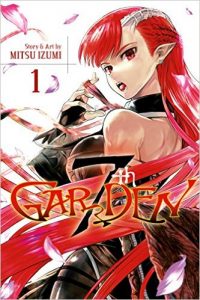By Mitsu Izumi. Released in Japan by Shueisha, serialization ongoing in the magazine Jump Square. Released in North America by Viz.
For a nation that mostly seems to revolve around Shintoism and Buddhism, Japanese manga authors seem very taken with Christianity. Not necessarily for the actual religious thought behind it, but I think they see the Bible as sort of a Lord of the Rings-type book, filled with epic battles between angels and demons, lots of divine punishment, and a few bouts of sinning for good measure. There have been quite a few stories talking about a battle between heaven and hell with Earth as its grounds, most famously Neon Genesis Evangelion, but Angel Sanctuary is also up there. 7th Garden is firmly along those lines, as a young man with a tortured past finds himself allying with a demon with a tortured past in order to protect his young mistress, who may in fact have a tortured past as well. All of this revolves around the symbols and imagery of Christianity, slightly distorted,
This actually ended up being a lot more wholesome than the descriptions I saw led me to believe – I probably should have guessed that give that the busty demon on the cover actually has her back turned to the reader, rather than facing them chest first. Said demon is Vyrde, who is accidentally freed by our hero from a thousand year sleep, and proceeds to be the best thing about this series once she wakes up. She’s playful, seductive, and amoral in just the right amount, and even the ‘sneak into the hero’s bed at night’ feels for once as if it didn’t come out of the pages of ‘Love Comedy For Beginners’. Probably because there’s not much love here – yes, there’s a suggestion that Awyn (the hero) and Marie (his mistress) sort of kind of like each other, but make no mistake about it: this is a battle manga, with ridiculous swordfights and lots of corpses.
I mentioned Christianity above, but given that in this series the demons are the good guys and the angels the bad guys (very common in manga), it’s unsurprising that this fantasy world calls it ‘anti-Quoristiantity’, enforced by ‘anti-Knights, who as you might imagine with a name like that tend to mete out anti-Justice. To be fair, we’re told that the mooks we see killing innocents here are not Knights but Apostles – those who were not good enough to be Knights so do the Church’s dirty work. This does allow our hero to be somewhat more cavalier about life and death than you’d expect from a Jump manga – then again, this is Jump Square, and Blue Exorcist can also have very ambiguous morality. The most interesting part of the manga may have been told the end, as we’re fed little droplets of backstory hints that might pay off. Who is Ashriel, really, and what does she know? (With a name like that, the foreshadowing isn’t subtle.) What do they mean by the village not existing? And is there any significance that our demon’s real name is so close to Awyn’s innocent mistress? (That last may be a no. I suspect it’s the Western name equivalent of Isumi and Izumi being nothing alike.)
There’s a lot of tease here but not much beyond promise, and the fighting is good but can get confusing (on a level of 1 to Trigun Maximum, it’s about a 4). But it does show promise, and I am interested enough to pick up a second volume. Recommended for those who like fantasy and don’t mind religion being used as a heavy spice.


Speak Your Mind